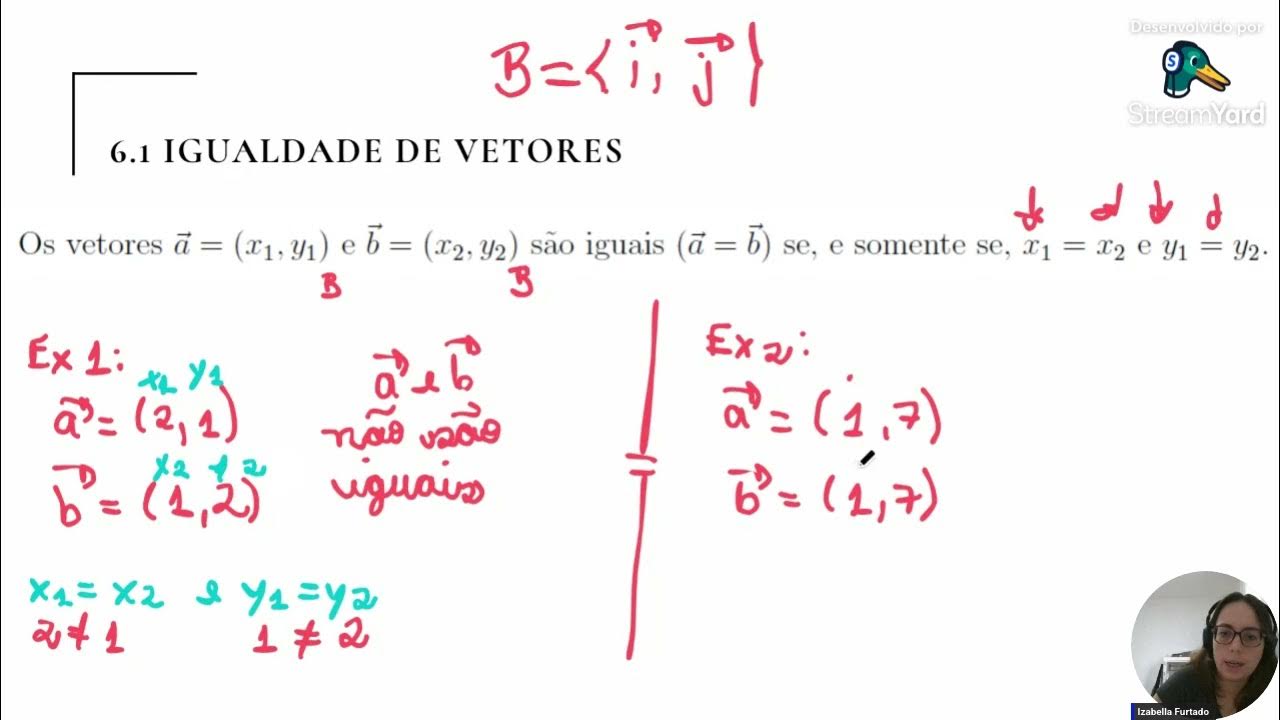Aljabar Linier - Ruang Hasil Kali Dalam - Perubahan Basis
Summary
TLDRThis video delves into the concept of changing bases in vector spaces, covering the importance of transitioning between different bases for various problems. It explains how to compute coordinate transformations, particularly focusing on orthogonal and orthonormal bases. The tutorial includes detailed examples of coordinate calculations using matrix transformations, and it touches on essential terms such as factor coordinates and transition matrices. This is a key topic in linear algebra that helps in understanding vector representation and transformations in different dimensional spaces.
Takeaways
- 😀 Changes in basis are necessary when the current basis is not suitable for solving a problem, leading to changes in coordinates.
- 😀 A change of basis can involve moving between spaces of different dimensions, such as from 3D to 2D or vice versa.
- 😀 One example of a basis transformation involves shifting coordinates, where new coordinates (x', y') are derived from the old ones (x, y) by adding or subtracting constants.
- 😀 The concept of 'coordinate factors' refers to representing vectors uniquely as linear combinations of basis vectors, with specific coordinates relative to the basis.
- 😀 An orthonormal basis allows for simplifications, as it leads to easier calculations when expressing vectors as linear combinations of basis vectors.
- 😀 A vector's coordinates in a new basis can be related to its coordinates in the old basis using a transition matrix, which involves multiplying by a matrix that transforms the old coordinates to the new ones.
- 😀 For example, if transforming between basis B and B', the transition matrix P relates the old coordinates to the new ones, and its inverse matrix Q does the opposite.
- 😀 The matrix transition allows for efficient computation of vector coordinates when switching between bases, using matrix multiplication.
- 😀 The lecture includes a specific example where two bases (B and B') are given, and the transition matrix P is used to calculate new vector coordinates.
- 😀 Finally, understanding the relationship between old and new coordinates, and how to use transition matrices for basis changes, is crucial in solving vector space problems.
Q & A
What is the main topic discussed in this script?
-The main topic of the script is about changes in the basis of vector spaces, particularly how different basis transformations impact coordinates and vector representations in various dimensions.
What does 'basis transformation' mean in the context of this script?
-Basis transformation refers to changing the basis of a vector space to better suit different problems or situations. It involves adjusting the coordinate system or the vector representation in a new basis.
How does a basis transformation affect the coordinates of a vector?
-A basis transformation can alter the coordinates of a vector. For example, the coordinates of a vector in one basis might differ when expressed in a new basis, as the transformation redefines the reference frame for the vector.
What is the significance of the orthonormal basis in the context of basis transformation?
-An orthonormal basis is significant because it simplifies calculations, particularly in transformations. In an orthonormal basis, the vectors are not only orthogonal (perpendicular) to each other, but also have unit length, which makes computing dot products and projections straightforward.
What does 'coordinate factor' mean in the context of the script?
-The 'coordinate factor' refers to the coefficients that describe a vector in terms of a given basis. These factors allow the vector to be expressed as a linear combination of the basis vectors.
How do you calculate the new coordinates of a vector when changing bases?
-To calculate the new coordinates of a vector when changing bases, you use a transformation matrix. The matrix is constructed from the relation between the old basis and the new basis. Multiplying the transformation matrix with the original coordinates gives the new coordinates.
What is the role of the matrix transition in basis transformation?
-The matrix transition plays a crucial role in changing coordinates between different bases. It is the matrix that represents how the old basis vectors are transformed into the new basis, enabling the conversion of coordinates.
What happens when you invert the transition matrix?
-Inverting the transition matrix allows you to reverse the transformation, converting coordinates from the new basis back to the old basis. This is important when you need to map between coordinate systems in both directions.
Can you give an example of calculating the new coordinates of a vector using a transformation matrix?
-Yes, if the original vector is represented by coordinates (x, y) in the old basis, and you have a transformation matrix relating the old basis to the new one, multiplying the transformation matrix by the vector's coordinates will give the new coordinates.
Why is it necessary to change the basis for different problems?
-Changing the basis can make solving certain problems easier. Different bases may simplify computations, such as finding projections, orthogonal components, or solving systems of equations, depending on the problem's structure.
Outlines

此内容仅限付费用户访问。 请升级后访问。
立即升级Mindmap

此内容仅限付费用户访问。 请升级后访问。
立即升级Keywords

此内容仅限付费用户访问。 请升级后访问。
立即升级Highlights

此内容仅限付费用户访问。 请升级后访问。
立即升级Transcripts

此内容仅限付费用户访问。 请升级后访问。
立即升级浏览更多相关视频

Lecture 05 : Basis and Dimension

Aula de Vetores- Parte II - G. A. e A. L.

Hidrolisis Garam (1) | Sifat Garam | Reaksi Hidrolisis

Espacios Vectoriales (Definición y ejemplos)

Pre-Algebra 3 - Decimal, Binary, Octal & Hexadecimal

Acids, Bases and Salts Class 10 Full Chapter (Animation) | Class 10 Science Chapter 2 | CBSE | NCERT
5.0 / 5 (0 votes)
